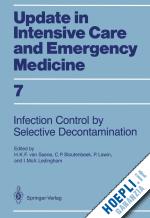Foreword.- One: Pathogenesis.- Host-microorganism Relationship in Healthy People.- Classification of Microorganisms Based on Intrinsic Pathogenicity.- Defence Against Colonization and Infection.- Oropharyngeal/Gastrointestinal Carriage: Role in Endogenous Colonization and Infection.- Discussion.- Host-microorganism Relationship in the Critically Ill.- Impaired Colonization Defence of the Oropharynx.- Impairment of Defence of the Stomach and Intestine against Colonization in the Critically Ill Patient.- Pathogenesis of Colonization/Infection of Lower Airways (Endogenous vs Exogenous): Conventional Approaches to Infection Control.- Discussion.- Two: The Conventional Approach to Infection Control.- Clinical Studies.- Prospective Study of Colonization, Infection and Mortality Rates during Conventional Therapy: Glasgow Data.- Infection and Mortality Rates in Critically Ill Patients during Conventional Antibiotic Regimen.- A Prospective Study of Colonization and Infection in the Neonatal Surgical Unit at Alder Hey Children’s Hospital, Liverpool, UK.- Surveillance of Nosocomial Infections in a Surgical ICU: A Prospective Study.- Prospective Study of Colonization, Infection and Mortality Rates during Conventional Therapy.- Infection Control in the ICU: Pattern of Colonization and Infection in Surgical Intensive Care Patients — a Prospective Study.- Discussion.- Antibiotic Resistance.- Where and How does Antimicrobial Resistance Develop in the Critically Ill? Studies in Neonatal Patients.- Do Conventional Policies Control Antibiotic-resistant Bacteria?.- Discussion.- Three: An Alternative Approach — Selective Decontamination of the Digestive Tract (SDD); the Use of Non-absorbable and Parenteral Agents.- Philosophy of SDD.- Concept of Selective Decontamination in the Critically Ill.- Topical Antibiotic Regimen.- Use of a Short-term Parenteral Antibiotic as a Supplement to SDD.- Pharmaceutical Technology, in Selective Decontamination.- Discussion.- Clinical Studies.- Prospective Study of Colonization, Infection and Mortality in ICU Patients Treated with SDD and Systemic Cefotaxime: Glasgow Results.- Prospective Study of Mortality Rates in Critically Ill Patients During SDD Regimen.- Prospective Studies of Colonization, Infection and Mortality Rates: Liverpool Data.- Infection Control by Selective Flora Suppression in Critically Ill Patients.- Prospective Studies of Colonization, Infection and Mortality Rates in ICU Patients Receiving SDD: Ulm Results.- Prevention of Colonization and Subsequent Infection in Critically Ill Patients: a Prospective, Randomized Study.- The Effect of a Novel Regimen of Selective Decontamination on the Incidence of Unit-Acquired Lower Respiratory Tract Infection in Mechanically Ventilated Patients.- Discussion.- Role of Endotoxin.- Significant Reduction of Faecal Endotoxin Pool by Oral Polymyxin E and Tobramycin in Human Volunteers.- Endotoxaemia in Multiple Organ Failure: A Secondary Role for SDD?.- Discussion.- Emergence of Resistance during SDD.- Cefotaxime Combined with Selective Decontamination in Long-Term Intensive Care Unit Patients: Virtual Absence of Emergence of Resistance.- Emergence of Resistance During Selective Decontamination: Glasgow Results.- Changes in Antibiotic Resistance in Tracheal Aspirates Following Selective Decontamination of the Digestive Tract.- The Liverpool Experience, 1987–1988.- Colonization and Resistance Patterns of Microbial Isolates Following SDD in Association with Short-Course Cefotaxime.- Gram-negative Bacillary Resistance in a Surgical Intensive Care Unit: A Four-Year Surveillance.- Discussion.- Four: Stress Ulcer Prophylaxis and Pneumonia.- Stress Ulcer Prophylaxis and Pneumonia.- Pathogenesis of Stress Ulcer Bleeding in the Critically Ill.- Gastric Colonization and Nosocomial Pneumonia in the Mechanically Ventilated Patient.- New Approaches to the Prevention of Infection in Intensive Care Unit Patients.- Discussion.- Five: Analysis of Conventional and SDD Approaches.- A Possible Explanation for the Success of SDD.- Discussion.- Impact of Parenteral Cephalosporins on Human Oropharyngeal and Faecal Flora.- Discussion.- Development of Antibiotic Resistance During Conventional and SDD.- The Gut and Sepsis in the Critically Ill.- Discussion.- Conclusions.- Close.- Appendices.- Appendix I: Formulations Used in Selective Decontamination.- Appendix II: List of Abbreviations.- Appendix III: Trials of Infection Rates Following Conventional Treatment and Selective Decontamination.











